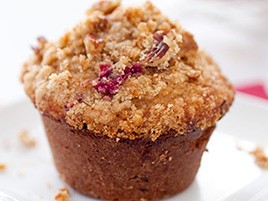Cranberry-Pecan Muffins

To tame the harsh bite of the cranberries found in most cranberry-nut muffins, we chopped the cranberries in a food processor and tossed them with confectioners’ sugar and a little salt (which we often use to tame the bitterness in eggplant). As for the nuts, we took a cue from cakes made with nut flour and augmented some of the all-purpose flour with pecan flour (made by grinding pecans in a food processor). But because we were working with less flour, our muffins spread rather than baking up tall and self-contained. We fixed the problem by letting the batter rest for 30 minutes. Resting allowed what flour there was to become more hydrated, resulting in a properly thickened batter that baked up perfectly domed. To replace the missing crunch of the nuts, we simply topped the muffins with a pecan streusel.
Streusel Topping
3 tablespoons all-purpose flour
4 teaspoons granulated sugar
1 tablespoon packed light brown sugar
2 tablespoons unsalted butter, cut into 1/2-inch pieces, softened
pinch salt
1/2 cup pecan halves
Muffins
1 1/3 cups (6 2/3 ounces) all-purpose flour
1 1/2 teaspoons baking powder
1 teaspoon salt
1 1/4 cups pecan halves, toasted and cooled
1 cup plus 1 tablespoon (7 1/2 ounces) granulated sugar
2 large eggs
6 tablespoons unsalted butter, melted and cooled slightly
1/2 cup whole milk
2 cups fresh cranberries
1 tablespoon confectioners' sugar
Note:
If fresh cranberries aren't available, substitute frozen: Microwave them in a bowl until they're partially but not fully thawed, 30 to 45 seconds.
1. FOR THE STREUSEL: Adjust oven rack to upper-middle position and heat oven to 425 degrees. Process flour, granulated sugar, brown sugar, butter, and salt in food processor until mixture resembles coarse sand, 4 to 5 pulses. Add pecans and process until pecans are coarsely chopped, about 4 pulses. Transfer to small bowl; set aside.
2. FOR THE MUFFINS: Spray 12-cup muffin tin with baking spray with flour. Whisk flour, baking powder, ¾ teaspoon salt together in bowl; set aside.
3. Process toasted pecans and granulated sugar until mixture resembles coarse sand, 10 to 15 seconds. Transfer to large bowl and whisk in eggs, butter, and milk until combined. Whisk flour mixture into egg mixture until just moistened and no streaks of flour remain. Set batter aside 30 minutes to thicken.
4. Pulse cranberries, remaining ¼ teaspoon salt, and confectioners’ sugar in food processor until very coarsely chopped, 4 to 5 pulses. Using rubber spatula, fold cranberries into batter. Use ice cream scoop or large spoon to divide batter equally among prepared muffin cups, slightly mounding in middle. Evenly sprinkle streusel topping over muffins, gently pressing into batter to adhere. Bake until muffin tops are golden and just firm, 17 to 18 minutes, rotating muffin tin from front to back halfway through baking time. Cool muffins in muffin tin on wire rack, 10 minutes. Remove muffins from tin and cool for at least 10 minutes before serving.
Helpful tips:
MAKE NUT FLOUR Instead of chopped nuts, we incorporate homemade toasted pecan “flour” into the batter, which lends the muffins richer, heartier flavor.
CHOP CRANBERRIES WITH SUGAR—AND SALT Processing the berries with confectioners’ sugar sweetens them; a dash of salt masks their bitter edge.
TOP WITH STREUSEL A classic nut streusel sprinkled over the top of the muffins adds rich buttery crunch and just a hint of sweetness.
RECIPE TESTING
Thickening Thin Batter
We thought a lack of gluten was causing our nut flour-base muffin batter to be thin and runny, leading to muffins that baked up flat. But when we accidentally let the batter rest briefly—a fluke occurrence when we walked away for 30 minutes—the batter thickened and the muffins baked up nice and tall. Could the rest be what improved the muffins' structure? We prepared another batch, this time deliberately letting the batter rest for 30 minutes before baking, and compared the results with muffins we baked right away. Once again, the rested batter thickened considerably and produced muffins with nicely domed tops, while the unrested batter was thin and created predictably flat muffins that spread across the tin.
After a chat with our science editor, we understood why: As batter rests, a small amount of gluten develops, providing structure. But the main effect is that water more fully hydrates the starches, causeing them to swell. This swelling thickens the batter and helps prevent it from spreading during baking.
None Available.